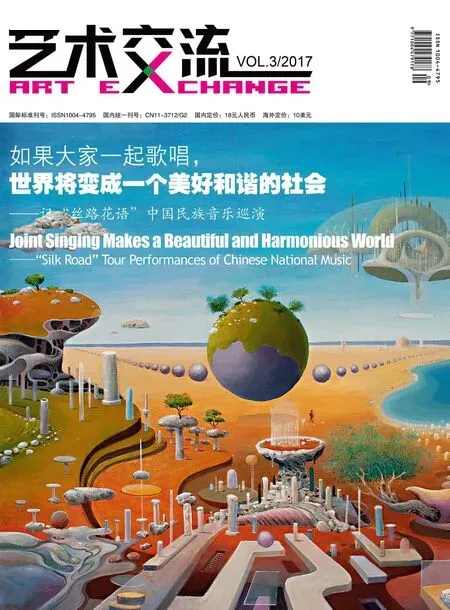擦肩而过的博物馆岛
2017-03-16羿明YiMing曹宇光CaoYuguang
文、图羿明Yi Ming 译曹宇光Cao Yuguang

柏林新博物馆一景Scene of the Neues Museum in Berlin
离开欧洲的前一天晚上在柏林观看演出,旁边是一位德国大爷,浓密的白胡须沿着上唇整齐地走了一排,典型的德国人特点。老先生将近70岁,退休以后开始学中文,目前已能用汉语简单交流,还会使用微信。他热情地向我推荐,到了柏林一定要去看一个东西。可说了半天,我还是没搞明白。感谢万能的网络,老者最后从手机里调出一幅图像,原来是——埃及王后纳菲尔缇缇!
想不到吧?埃及王后的塑像居然在柏林。可惜我们在柏林待了三天,离收藏埃及王后塑像的博物馆仅仅一两公里远,却错过了机会,没能亲自看上一眼。美丽擦肩而过。
我们参加活动的地方,紧邻施普雷河,从河边桥上很容易看到一个巴洛克风格的巨大建筑,高大的圆形穹顶甚为引人注目。走进细看,知道是博德博物馆,以收藏宗教题材的塑像和钱币为主。一座这样的博物馆建筑已令人叹为观止,可就在这座博物馆后面,还有四座更大的博物馆,构成蔚为壮观的博物馆群——博物馆岛。
施普雷河从博德博物馆那里分成两支,中间形成博物馆岛。17世纪中叶前,这里还是普鲁士的皇家菜园。1825年至1830年,博柏林老博物馆在此设计建成,成为岛上最早的博物馆,也是德国最早的独立博物馆之一。柏林老博物馆正面由古希腊式的柱廊组成,气势宏大,正对面是原来的柏林王宫。这里收藏的雕塑、古希腊陶罐和马赛克作品颇有特点。
与柏林老博物馆相应的是柏林新博物馆。虽然名字里有一个“新”字,却收藏了人类文明中最古老的艺术品。柏林新博物馆是岛上建成的第二个博物馆,埃及王后纳菲尔缇缇的头像就保存在此处,为岛上最为举世闻名的藏品。柏林新博物馆为此专设展厅,其他展品均可拍照,唯独埃及王后禁止。
岛上最年轻的建筑是于1909年至1930年间建成的帕加马博物馆,这也是岛上唯一一个以藏品命名的博物馆。其中的帕加马祭坛,曾经是古希腊殖民城邦帕加马的重要祭祀场所之一,祭坛台座的高浮雕壁带,是古希腊的雕塑艺术典范。此外,这里还收藏了公元前6世纪古巴比伦的城门——伊斯塔尔门。伊斯塔尔门是20世纪初德国在美索不达米亚的考古发现,当时有几十万片琉璃碎砖被运到柏林,经过脱盐、加固之后重新拼合,再现了东方古国的神秘气韵。帕加马祭坛与伊斯塔尔门一起,每年为帕加马博物馆带来上百万人次参观者。
全世界最古老的文明,古巴比伦文明和古埃及文明的文物精品,在博物馆岛上均能看到。二战期间,据说岛上70%的建筑被毁,很多文物流散各地。后来,文物陆续回流,博物馆得以重建。现在很多建筑的廊柱、墙壁上,依然可以看到二战时期留下的弹孔。1999年,博物馆岛入选联合国教科文组织“世界文化遗产名录”,据说2027年将完成全部整修工程。
虽然博物馆岛远不及卢浮宫有名,但博物馆组团带来的震撼依然难于言表,总的感觉是体量巨大,有种凝重崇高之美。另外,对于喜欢建筑的朋友,岛上五座建于不同时期的博物馆,风格各异,再加上紧邻的柏林大教堂,以及几步之遥正在施工复建的柏林王宫,一起构成了一座建筑与文化的奇观。
On the last evening of my trip in Europe, I was watching a performance in Berlin. nd next to me sat a senioraged German senior citizen whose thick white moustache lined straight along his upper lip. As a typical German,he was almost in his 70s. After his retirement, he started to learn mandarin and currently could communicate with me in a simple Chinese as well as utilize WeChat App on his mobile phone. In a genuine passion, he recommended a must-see in Berlin, but his limited Chinese and my poor English made his long explanation more confusing to me. Thanks to the versatile Internet, he finally found a picture from the searching engine in his phone and showed it to me. Actually, it was Nefertiti, the Egyptian queen.
It was a quite unexpected fact that the bust of such a famous Egyptian queen as Nefertiti was available in Berlin. Throughout our three-days stay in Berlin, we were always one or two kilometers away from the museum of Nefertiti collection. It was quite a pity that we missed such a priceless opportunity to appreciate her beauty.
The venue of our event that we attended was close to Spree river, and standing on a bridge over the river,we could easily find a giant building in Baroque style as its lofty and round dome was quite outstanding.Taking a closer look, we could recognize it as the Bode Museum with major collections of sculptures and coins of religious themes. Such a museum was already an acme building in our mind,but just behind it there stood another four larger museums, all of which constituted a magnificent complex of museums, i.e., the Museum Island.
Starting from the Bode Museum, the Spree river divides in two tributaries branches and in the middle stands the Museum Island.Before the mid-17thcentury, it had been a royal vegetable garden of the Kingdom of Prussia. Between 1825 and 1830, the Altes Museum (Old Museum) was designed and constructed, and then became the first museum on this island as well as one of the earliest independent museum in Germany. The front of the Altes Museum consists of magnificent colonnade of ancient Greek style in a magnificent manner, facing the old royal palace in Berlin in the past. Sculptures, ancient Greek pottery and mosaics are quite typical here.

柏林老博物馆正门入口处的雕塑Sculpture at the entrance of the Altes Museum gate
Correspondingly, there exists the Neues Museum (New Museum)on the same island. Though it is called “New”, its collection involves the most ancient artworks in human civilization. As the second eldest museum on the island, the bust of Egyptian queen Nefertiti was kept in a separate exhibition hall as the most notable exhibit. In this museum, pictures can be taken with other exhibits except Nefertiti.
The youngest building on this island is Pergamon Museum that was constructed from 1909 till 1930, and it was the only one named after its exhibit. The Pergamon Altar used to be one of the key sacrifice venue in Pergamon, an ancient Greek colonized city-state. The frieze in high relief decorated on the base is an example of sculpture arts in Ancient Greece. Besides, Ishtar Gate,the eighth gate to the inner city of Babylon in the 6thcentury B.C., was within its collection. The ruins of the Ishtar Gate were discovered in an archaeological survey by German experts in Mesopotamia at the beginning of the 20thcentury A.D. After that,hundreds of thousands of broken pieces of colored glaze were transported to Berlin, and after being desalted and consolidated,they were pieced together to restore the mysterious charm of
that Oriental civilization.Both Pergamon Altar and Ishtar Gate have brought over a million visitors annually to the Pergamon Museum.
The cream of relics in ancient Babylon civilization and ancient Egypt civilization, the most time-honored civilizations in the world,are still available on the Museum Island. It is said that during the Second World War, 70 percent of the buildings on this island were destroyed and many relics were spread all over Germany. Later on, those relics luckily returned home and those museums were consecutively reconstructed. On many pillars and walls of those museums, some bullet holes are still visible. In 1999, the Museum Island was listed into World Cultural Heritage by UNESCO and reportedly the entire renovation will be completed by 2027.
Though Museum Island is not as well-known as the Louvre, the visual shock by this giant complex is far from verbal description.In a word, this gigantic complex of museums portrays a beauty of noble dignity. Furthermore, in the eyes of architectural fans,those five museums of different styles in varied times, along with the next-door Berlin Dome and the Berlin Palace under renovation, have constituted a miracle of architecture and culture.

柏林新博物馆外的柱廊,上面依然有战争留下的弹孔Shot Marks in the Second World War are still Visible in the External Colonnade of the Neues Museum in Berlin

由北京画院主办的“光影岿然——沙飞的艺术·理念·行动”展于8月18日至9月26日在北京画院美术馆展出。图为著名摄影家沙飞拍摄的《人力车夫》Sponsored by Beijing Fine Art Academy, “Steadfast Light and Shadow—Photographer SHA Fei’s Art · Concept · Action” Exhibition was Held in the Art Museum of Beijing Fine Art Academy from August 18 till September 26. The Above Photo is Rickshaw Puller Taken by the Well-known Photographer SHA Fei

